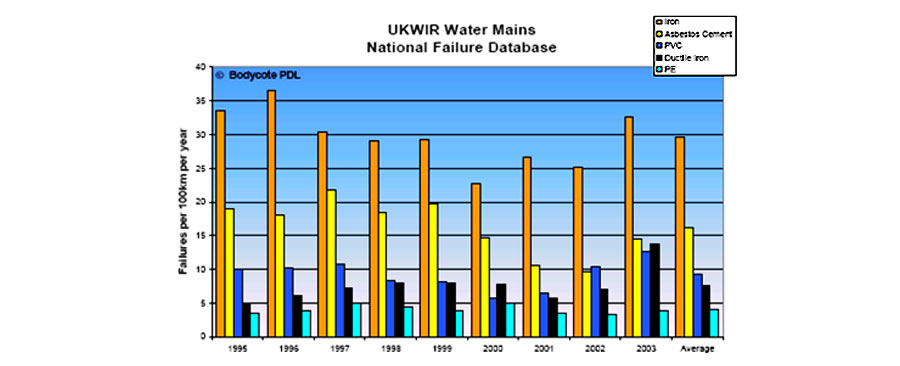Welcome to Jain Irrigation Systems Ltd.

Blog at Jains - PE Piping Systems

2.Why PE Pipes : Of all the Pipes used globally, Plastics (PE and PVC) Pipes form around 40% share (Fig. 2). India is no exception to this, although there is a slight lag in under-standing of Plastics as Piping materials. Designers & Utility authorities used to stick to the traditional Piping and were seen not taking risks with materials they did not know. This is definitely changing now with the world wide popularity of PE Piping (Fig.3 & 4).

| Region | 1990 (KT) | Growth % | 2000 (KT) | Growth % | 2010 (KT) |
| Asia | 95 | 27.9 | 360 | 21.9 | 1150 |
| Japan | 70 | 2 | 84 | 1.9 | 100 |
| M. East | 25 | 26 | 90 | 11.1 | 190 |
| S. Africa | 25 | 18 | 70 | 12.9 | 160 |
| Africa | 20 | 20 | 60 | 7.5 | 105 |
| E. Europe | 80 | 12.5 | 180 | 9.2 | 345 |
| W. Europe | 395 | 9 | 750 | 7.7 | 1330 |
| NAFTA | 335 | 16.9 | 900 | 7.8 | 1600 |
| TOTAL | 1045 | 13.9 | 2494 | 10 | 4980 |
| PE Pipe End-Use Segment | 2011 (KT) | 2015 (KT) |
| Trade-Agri | 54 | 95 |
| Water | 39 | 65 |
| Sewerage | 14 | |
| Industrial | 25 | 50 |
| Gas Distribution | 3 | 22 |
| Telecom Duct | 47 | 56 |
| Total | 168 | 302 |


- Easy & Fast installation : The low weight and easy handling of Plastics Piping systems helps faster project execution leading to lower cost/time over-runs
- Leak proof monolithic joint stronger than the Pipe itself : Globally proven record of lowest joint failures and lowest %age of NRW (Non-Revenue Water) (Fig. 9 ). Muncipalities are choosing PE Pipes to reduce water loss and provide 24 x7 water availability (eg. Karnataka, Nagpur, New Delhi, etc)
Fig. 9 United Kingdom Water Mains National Failure Database

- Lower cost of appurtenances : Ability to withstand higher water hammer or surge pressures
- Lesser requirement of specials/bends : Unique cold bending radius property (20-25 times the diameter of Pipe) of PE Pipes leading to lower capital cost
- Suitable for soil settlement/earthquake prone areas : PE Pipes are have flexibility and ability to take the contours of the most undulating of terrains
- Long service life of 100 years or so (for Pipe of proper quality, correct jointing and installation) .
Fig. 10 PE Piping for underground Fire Hydrant

- Highest abrasion resistance amongst Piping materials : Mining industry uses PE Piping for dewatering/slurry transport
- Suitable for trenchless procedure , and HDD (Horizontal Directional Drilling) applications : CGD (upto 16 bars) & Telecom Networks invariably use PE Piping for Gas conveyance and for carrying OFC. These Pipes are being laid by no-dig or trenchless procedures thereby preventing traffic/public disruption and inconvenience.
Fig. 11 HDD or Trenchless Installation in Graphics

- Excellent Chemical Resistance : Ideally suited for aggressive (alkaline / acidic) soils , Process Plants and Effluent discharge.
- Ideally suited for Sewerage application : PE Pipes are inert to Sewer Gases such as H2S, etc. Crowns of Cement Pipes fail due to aggressive nature of sewerage
Fig. 12 1200 mm PE Pipes for Sewerage Force/Pressure Mains in Delhi

- Ideally suited for Sea/River water intake Piping, and marine outfalls : Unlike metal Pipes, PE Pipes do not corrode . Desalination Plants (SWRO, BWRO) across the world use only PE Piping.
Fig. 13. 1600 mm PE Pipes for Sea Water Intake & Marine Outfall of a Desal Plant in S. India

- No failures due to galvanic action in soil : No requirement of cathodic protection)
- No protective internal/external linings required : As in DI Pipes and Cement Pipes
- Low first cost : At least upto 700-800 mm diameters , as compared to DI Piping
- Lowest Life Cycle Cost (or Cost of Ownership)
Muncipal Corporations/Utility Bodies in India and other countries , have realized the need to control non-revenue water (NRW - euphemism for water loss) and make their citizens sensitive to finite availability of potable water, and water conservation. PE Pipes are coming in handy to fulfill these objectives .
The challenge in Developed Countries : PE Pipes are seeing a resurgence of growth in developed world also due to the need of these countries to replace the old networks (come up progressively over the last 100 years or so) made with traditional Piping like metal (CI, GI, MS, etc) and cement pipes(RCC & AC Pipes). Increased activity in Coal Seam Gas/Shale Gas generation, Desalination, Broadband Networks, Mining, etc. is also leading to increase in use of PE Piping materials at a much higher rate of growth than anytime in the past.


